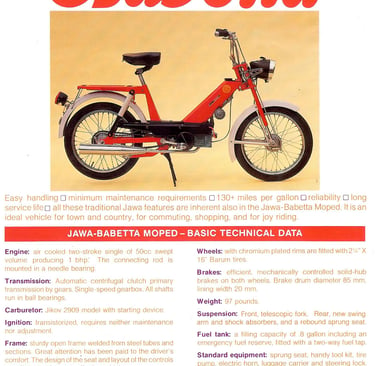Babetta 210: JAWA's Two-Wheeled Symphony of Evolution and Reliability
The JAWA Babetta 210 moped, also known as 'Babetta', was a Czechoslovakian collaboration between the 'Povazske Strojarne' factory and JAWA. It was the first moped to feature an electronic ignition and had a simple design with a 50cc two-stroke engine. The Babetta 210 offered a distinctive performance and user experience, although some models had transmission reliability issues.
MOPEDSJAWACLASSIC MOPEDS1970'STWO STROKECZECHOSLOVAKIA
11/22/20232 min read


Babetta 210: JAWA's Two-Wheeled Symphony of Evolution and Reliability
History of the JAWA Babetta 210 Moped
The JAWA Babetta 210 moped, also known as 'Babetta', was a product of a Czechoslovakian collaboration, marking a point of rich historical significance. Born out of the necessity for alternative production in a post-war economy, the bike-making venture was initially a co-operation between the 'Povazske Strojarne' factory and JAWA, a company with prior experience in arm production to motorcycle production transition.
The evolution of the Babetta mopeds began in 1971 with the release of the type 28, distinguished by its large 19-inch wheels and later replaced with more feasible 16-inch wheels in subsequent models. As a significant historical point, the Babetta moped was the first moped to feature an electronic ignition through a transistorized contactless ignition.
The series interrupted the market, housing mopeds with a single-speed or a 2-speed automatic transmission. Various revisions and improvements over the years led to the unveiling of the Babetta 210 in 1983. The 210 version sported a new engine and a 2-speed transmission, although the 2-speed feature was later declined due to reliability issues.
Design and Features of the JAWA Babetta 210
The JAWA Babetta 210 was more than just a moped; it was a medley of streamlined design and innovative technical features. This moped had a simple design with a single-track motor, making it uncomplicated to handle. The unique design of the JAWA Babetta 210 encompassed a 50cc two-stroke engine, sufficient to provide optimal performance within urban environments.
In the initial conception, Babetta was devised as a lightweight moped to rival the prevailing VéloSoleX (Solex) moped. A noteworthy aspect of this moped was its comprehensive redesigning in the model 210, which introduced a new engine and initially a 2-speed transmission, which was later swapped for a 1-speed transmission due to reliability concerns. Multiple models, subsequently, were based on the Babetta 210, bringing a variety of choices for the consumers.
Performance and User Experience
The JAWA Babetta 210 offers a distinctive performance and user experience. Its simplicity of design and easy handling make it an appealing choice for many riders. Not only that, but the bike's lightweight design and unique engine traits maximize its efficiency. It's perfect for anyone looking for a simple, dependable mode of transport that's easy to maintain.
Reportedly, the mopeds don't have a significantly high top speed, but their acceleration and hill-climbing prowess are commendable. On the downside, certain models of the Babetta 210 have been reported to show transmission reliability issues, which led to the retrofitting of a 1-speed transmission in place of the initial 2-speed design.
Overall, the JAWA Babetta 210 has won over many hearts with its blend of simplicity, efficiency, and a nostalgic hint of vintage charm.
